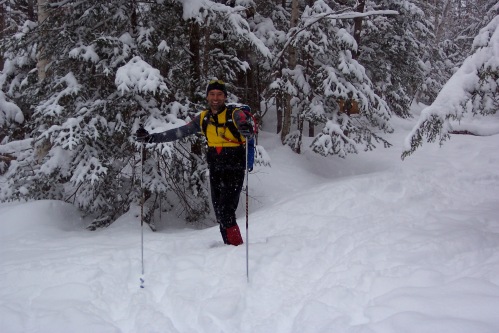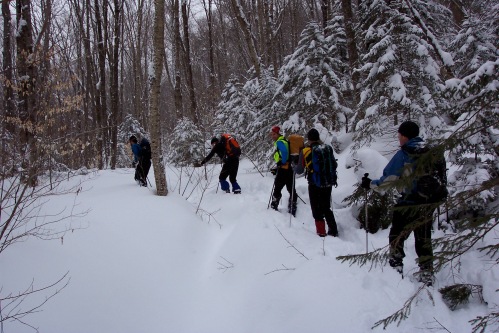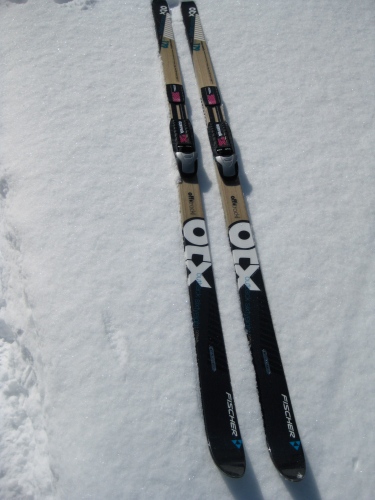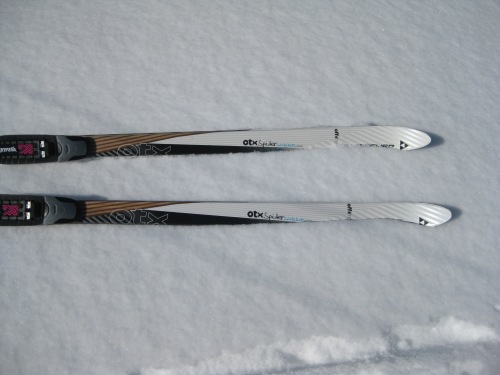In honor of the impending arrival of winter, here’s a short story of an epic backcountry ski trip that happened about 5 years ago:
Being middle-aged men, my friends and I like to take on adventures that test the limits of our endurance. The reasons for this are not entirely clear but I think it has something to do with proving we are still physically viable even as we approach the age of 50. They also provide the excuse for multiple “planning sessions” where beer is consumed and maps are stared at, the whole thing usually devolving into a bullshitting session where the same old stories are trotted out and many laughs are had. In fact, these sessions might be my favorite part of any trip.
On this occasion, we felt it was a good idea to traverse the Pemigewasset Wilderness on skis in one day. Sounds simple enough: 25 miles on metal-edged backcountry skis through one of the true wilderness areas of New England. We’d go light with day packs and minimal supplies so, as my friend Eddie likes to say, we could “flash” the route quickly.
The start was at Lincoln Woods trailhead on the Kancamagus Highway near Lincoln, New Hampshire. We would proceed north on the Lincoln Woods Trail, hang a right and head east on the Wilderness Trail, turn north again onto the Shoal Pond Trail after crossing the Pemigewasset River, hook up with the Ethan Pond Trail and eventually ski out to route 302 on the Zealand Trail. This route would bypass the more popular route of heading up the Thoreau Falls Trail and send us instead to the more remote eastern side of the wilderness. Since seeking out places where there would be few or no other people was also part of our modus operandi, this seemed like the prudent thing to do.

Snow, snow, snow
Because of snowy weather, we arrived at the trailhead quite a bit later than planned. As we were suiting up in the little visitor’s center a park ranger came in and asked what we were up to. When informed of our ambitious plans, he looked quite skeptical. It was already 8 am and he thought we were getting a very late start. We assured him that we were a strong group and we would be okay. He nodded but I could tell he was thinking to himself “great, I’ll be out here tonight trying to rescue these clowns.”
Speaking of clowns, we were a strong group, several of whom had lots of backcountry ski experience. Only my friend Marcio, originally from Brazil, was relatively inexperienced on snow. But he was easily the fittest of the bunch and could keep going forever.
The first few miles on the heavily trafficked Lincoln Woods Trail were fast and easy. So many people had skied it that it was almost like a groomed touring center. Once on the Wilderness Trail there was less sign of traffic but the trail was still well-tracked and fast. Things started to get interesting after we passed the turnoff to the Thoreau Trail. It was clear everyone went up the Thoreau Trail.

Starting to sense the epicness.
The eastern end of the Wilderness Trail was where things started to go downhill. There was no evidence that anyone had skied or snowshoed on it. And the snow was getting deeper the further we went. Soon we were trudging through knee-deep powder. To make matters worse, there was an increasing number of washouts cutting through the trail. At each one, we had to sidestep down into a small ravine and then climb out the other side. Some had running water in them, necessitating time-consuming route-finding forays. Soon progress was reduced to a crawl.
After about 9 miles we reached the crossing of the Pemigewasset River. Here we’d pick up the Shoal Pond Trail on the other side of the river and ski due north along Shoal Pond Brook. Problem was it was already 2 pm, only 4 hours of daylight remained and we were not even halfway. I suggested that maybe we should turn back because of the late hour. De facto trip leader Eddie got annoyed and said “turning back is not an option!” When more experienced members Jim and Brian didn’t say anything I clammed up and went along. In hindsight, I was the one making the right call. Rule #1 of any backcountry expedition: turning back is always an option.
We knew if we reached the heavily traveled Ethan Pond Trail four miles away, we’d be able to ski out by headlamp on a nice tracked out trail. But first we had to negotiate the Shoal Pond Trail, which we didn’t know anything about. We were soon to become very intimate with it, however.
Almost instantly we lost the trail. After getting back on course, the snow was now so deep the blue blazes that served as trail markers were about a foot off the surface. We wallowed up to our thighs searching for blazes, which were now fewer and farther between. Judging by the condition of the blazes and the state of the trail, it was obvious the Shoal Pond Trail did not get much use and even less in the way of maintenance. Nonetheless we plowed ahead, fueled by that peculiar brand of stubbornness that can only be produced by a group of men. No one wanted to be the person who called it quits.
The map indicated a crossing of Shoal Pond Brook but none appeared. Finally the blazes disappeared and we frantically searched for the crossing. The snow was so deep the tops of small trees were bent over and buried with branches barely sticking out. Our skis got hung up in them and further slowed our progress. We were skiing through the tree tops. After an hour of looking the brook crossing was discovered. On the other side the trail went up a horrendously steep climb which leveled off reluctantly. Here there were more tree tops to thrash through.
Feeling strong I went to the front of the group and started pushing hard to make it to the Ethan Pond Trail before dark. I had never seen snow so deep, the blazes were all but buried but I could make out a tunnel through the trees, probably the result of the trail originally being a cart road of some sort. The light was fading fast but I kept pushing on. Finally, someone yelled out to stop. It was 6 pm and completely dark. The only choice was to put our headlamps on, turn around and follow our tracks out. We had skied approximately 12 miles in 10 hours. It had taken 4 hours to ski 3 miles of the Shoal Pond Trail. We weren’t even halfway. Talk about biting off more than you can chew.
The weather grew snowy, windy and cold. We could have spent the night out but it would have been mighty uncomfortable. Following our tracks out sounded easy but we still had to deal with the same obstacles all over again. Fatigue was also setting in for a couple members. We plodded along, thankfully the snow was not filling in our tracks too much. At 1 a.m. we emerged into the parking lot at the Lincoln Woods trailhead. We had been on the trail for 17 hours. We still had to drive home to Portland in a snowstorm.
And that’s what middle-aged men do for fun. At least my group of middle-aged men. Sure beats sitting around watching reality TV.




